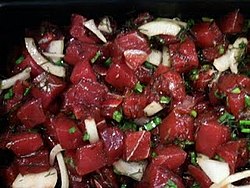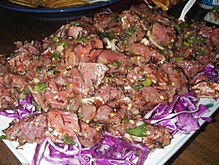food.wikisort.org - Dish
Poke /poʊˈkeɪ/ (Hawaiian for "to slice" or "cut crosswise into pieces";[3][4] sometimes anglicised as 'poké' to aid pronunciation[5][6][7]) is diced raw fish served either as an appetizer or a main course and is one of the popular dishes in Hawaii. Traditional forms are aku (skipjack tuna) and heʻe (octopus). Heʻe poke is sometimes called tako poke in places where the Hawaiian language is not spoken.[8] Poke differs from other raw fish dishes in that it does not use citrus fruits as a curing agent.
 Poke made with tuna, soy sauce, Hawaiian sea salt, green onions, Maui onions, rice and limu | |
| Place of origin | Ancient Hawaii[1][2] |
|---|---|
| Region or state | Hawaii[1][2] |
| Main ingredients | skipjack tuna, sea salt, soy sauce, inamona, sesame oil, limu seaweed, chili pepper |



History
Poke began with fishermen seasoning the cut-offs from their catch to serve as a snack.[9] According to the food historian Rachel Laudan, the present form of poke became popular around the 1970s. It used skinned, deboned, and filleted raw fish served with Hawaiian salt, seaweed, and roasted, ground candlenut meat. This form of poke is still common in the Hawaiian islands.[2]
Beginning around 2012, poke became increasingly popular in North America.[10][11][12] From 2014 to mid-2016, "the number of Hawaiian restaurants on Foursquare, which includes those that serve poke," doubled, going from 342 to 700.[10] These restaurants serve both traditional and modern versions of the dish. The modern version is sometimes called poké bowl, and may have the ingredients arranged in a grouped way rather than mixed. Contemporary poke restaurants are mostly—but not exclusively—fast casual style restaurants where the dish is fully customizable from the base to the marinade on the fish.
There is a three-day "I Love Poke" festival held in San Diego yearly to celebrate the dish and its many variations.[13]
Ingredients
The traditional Hawaiian poke consists of fish that has been gutted, skinned, and deboned. Traditional Hawaiian poke may consist of cubed raw fish, maui onions, inamona (roasted, crushed and salted candlenut), green onions, and/or sesame oil.[14] It is served with traditional condiments such as Hawaiian sea salt and limu.[9]
Modern Hawaiian versions of traditional poke seasonings have been heavily influenced by Japanese and other Asian cuisines, such as soy sauce, furikake (mix of dried fish, sesame seeds, and dried seaweed), chopped dried or fresh chili pepper, fish eggs, and wasabi. Fish types may include cured heʻe (octopus), other types of raw tuna, raw salmon and various kinds of shellfish.[8]
North American variations may include ponzu sauce, teriyaki sauce, soy sauce, sriracha sauce, and mayonnaise as sauces, and avocado, mushrooms, crispy onions, pickled jalapeño, cilantro, pineapple, cucumber, edamame, green onions, and a variety of other fusion cuisine vegetables among the chopped ingredients. Unlike traditional Hawaiian poke, the mainland style is typically not pre-marinated, but is instead prepared with sauces on demand. A variety of fish may be available, with ahi tuna the most popular, and yellowtail, salmon, octopus, crab, and imitation crab as common additional choices. An option to add a base of cooked rice is not uncommon.

Similar dishes
Poke is similar to other Polynesian fish salads such as ika mata in the Cook Islands, kokoda in Fiji, oka in Samoa and 'ota 'ika in Tonga.[15]
A very similar dish is the kinilaw of the Philippines. Kinilaw is usually raw diced fish marinated in citrus juice, sour fruits, or vinegar with extracts from mangrove bark or fruits (and sometimes coconut milk). This process can also be applied to other seafood and lightly blanched or grilled meat (the latter being generally differentiated as kilawin).[16][17][18] The dish was introduced to Guam during the Spanish colonial period, resulting in the derivative Chamorro dish of kelaguen.[19][20]
The Ilocano dish poqui poqui of the Philippines also likely derived its name from poke, after the influx of Ilocano sugarcane workers to Hawaii during the American colonization of the Philippines. However, they are very different dishes, with poqui poqui being a scrambled egg dish with grilled eggplants and tomatoes.[21][22]
Raw fish dishes similar to poke that are often served in Europe are fish carpaccio and fish tartare. Also similar to poke are Korean hoe-deopbap, marinated raw tuna served over rice, and Peruvian ceviche. Japanese sashimi also consists of raw seafood; other similar Japanese dishes are zuke don, a donburi dish topped with cured fish (usually tuna or salmon) along with avocado topped with furikake, and kaisendon, a more elaborate version served with additional non-fish toppings.
See also
References
- Matt Dean Pettit (10 April 2018). The Great Shellfish Cookbook: From Sea to Table: More than 100 Recipes to Cook at Home. Appetite by Random House. p. 161. ISBN 978-0-14-753058-5.
- Laudan, Rachel (1996). The Food of Paradise: Exploring Hawaii's Culinary Heritage. University of Hawaii Press. pp. 37–38. ISBN 9780824817787. Retrieved 2017-01-28.
- Martha Cheng (24 January 2017). The Poke Cookbook: The Freshest Way to Eat Fish. Potter/Ten Speed/Harmony/Rodale. pp. 7–8. ISBN 978-0-451-49807-6.
- Mary Kawena Pukui and Samuel Hoyt Elbert (2003). "lookup of poke". in Hawaiian Dictionary. Ulukau, the Hawaiian Electronic Library, University of Hawaii Press.
- Noguchi, Mark. "A Conflicted Chef From Hawaii Reacts to the Mainland Poke Bowl Trend". First We Feast. Retrieved 11 June 2018.
- Tan, Rachel. "6 Things To Know About Hawaiian Poke". Michelin Guide. Retrieved 11 June 2018.
- Cheng, Martha. "How the Hawaiian poke bowl became the world's new fast food". Hawai'i Magazine. Retrieved 11 June 2018.
- Talwar, Kalei (17 July 2009). "Make Hawaii-style ahi poke wherever you are. Here's a recipe". Hawaii Magazine. Retrieved 2015-11-24.
- "Hawaiian Ahi Tuna Poke Recipe and History, How To Make Poke, Whats Cooking America". whatscookingamerica.net. Retrieved 2015-11-24.
- Vince Dixon, Data Dive: Tracking the Poke Trend: Proof that the Hawaiian dish is here to stay, Eater (September 14, 2016).
-
- Catherine Smart, The Hawaiian raw-fish dish poke is having a moment, Boston Globe (December 27, 2016).
- Laura Hayes, What Does a Hawaii-Born Chef Think of D.C.'s Poke Craze?, Washington City Paper (April 13, 2017).
- Jay Jones, Hawaii's endless poke craze, stoked by new twists and traditional dishes, Los Angeles Times (May 12, 2016).
- Hillary Dixler, Can Poke Be the Next Fast-Casual Trend? Why restaurateurs are building brands around the Hawaiian staple, Easter (January 22, 2016).
- Fabricant, Florence (2016-01-26). "Poké, a Hawaiian Specialty, Emerges in Chelsea". The New York Times. ISSN 0362-4331. Retrieved 2017-05-05.
- Stradley, Linda (2015-05-16). "Hawaiian Ahi Tuna Poke Recipe, Whats Cooking America". What's Cooking America. Retrieved 2017-05-04.
- Namkoong, Joan (2001-01-01). Go Home, Cook Rice: A Guide to Buying and Cooking the Fresh Foods of Hawaiʻi. Bess Press. ISBN 9780964335929.
- Grant, Ginny. "Ika mata recipe". Cuisine. Retrieved 5 April 2019.
- Ninah Villa (27 June 2015). "Kinilaw History, Origin and Evolution – Into the Heart of Freshness". Pinoy Wit. Retrieved 16 January 2017.
- "Tabon Tabon Fruit". Market Manila. 8 January 2008. Retrieved 16 January 2017.
- Alan Davidson (2014). The Oxford Companion to Food. OUP Oxford. pp. 445–446. ISBN 9780191040726.
- "Chicken Kelaguen & Flour Titiyas". Annie's Chamorro Kitchen. 29 July 2013. Retrieved 16 January 2017.
- "Exploring Chamorro Cuisine". Just Wandering. 20 June 2011. Retrieved 16 January 2017.
- Barnes, Patti. "24 Egg Recipes That Are Totally Cracked (But We Have To Try)". TheRecipe. Retrieved 18 December 2019.
- "You Are Probably Wondering How the Filipino Dish "Poqui Poqui" Got Its Name". Yummy.ph. Retrieved 18 December 2019.
- Titcomb, Margaret (1972). Native use of fish in Hawaii (2nd ed.). Honolulu, Hawaii: University of Hawaiʻi Press. ISBN 9780870227974. OCLC 309517.
External links
На других языках
- [en] Poke (Hawaiian dish)
[es] Poke
El poke (en hawaiano ‘sección’ o ‘cortar’) es una ensalada de pescado crudo servida como aperitivo o plato principal en la cocina hawaiana.[2] Las formas tradicionales son el aku (atún listado) y el he'e (pulpo). El poke de he'e suele llamarse por su nombre japonés tako poke, excepto en lugares como la isla de Ni'ihau donde se habla la lengua hawaiana. El poke de ahi, cada vez más popular, se prepara con atún de aleta amarilla. Algunas variaciones pueden incluir salmón crudo o varios mariscos como ingrediente principal, sirviéndose crudo con los condimentos comunes del poke.[3][4][ru] Поке
По́ке[1][2] (гав. poke [ˈpoke] — нарезать, резать на куски[3][4]) — одно из основных блюд гавайской кухни, салат из сырой рыбы, нарезанной кубиками, которую подают или как закуску, или как основное блюдо. Как правило, для приготовления поке используют или осьминога, или тунца. Блюдо с осьминогом обычно называют Тако Поке (за исключением острова Ниихау, на котором говорят на гавайском языке). Тунец, используемый в блюде, как правило, желтопёрый. В другие варианты поке добавляют сырого лосося или моллюсков. Блюдо подают с сыром и тыквенными приправами (рыба подаётся в сыром виде)[5].Другой контент может иметь иную лицензию. Перед использованием материалов сайта WikiSort.org внимательно изучите правила лицензирования конкретных элементов наполнения сайта.
WikiSort.org - проект по пересортировке и дополнению контента Википедии